The Praetorian Guard functioned as both political police and elite military, but proximity to the emperor made them preeminent kingmakers whose coercive power repeatedly determined succession. Across three centuries—from Augustan design to Constantine’s abolition—the Guard shifted from protective corps to an institution that could unmake emperors as readily as it protected them.
The Praetorian Guard sits at the center of a paradox in Roman imperial history. Conceived to protect the person of the emperor and the stability of the Principate, the Guard became the very lever by which emperors were overthrown, acclaimed, or extorted. Their barracks and blades stood closer to power than any provincial legion; their prefects could make policy, and sometimes history. The classic question—were they political police or military force?—is best answered by recognizing that the Praetorians were the institutional hinge between coercion and legitimacy in the imperial capital.
“Quis custodiet ipsos custodes?” is no mere epigram in their case. The Guard policed the palace and the political life of Rome, but their authority ultimately rested on martial capability. When they guarded the emperor, they embodied the state; when they turned, they exposed the state’s deepest vulnerability: that the imperial office must be accepted by those who wielded the immediate instruments of force. As the Roman aphorism ran, imperatorem facit exercitus.
This essay examines the Guard from Augustus’s founding vision through Tiberius’s consolidation and the construction of the Castra Praetoria, major interventions in the imperial succession (Caligula, Commodus, Pertinax), the notorious auction to Didius Julianus, and the final suppression by Constantine in 312. Along the way it explores organization, recruitment, ideology, and the peculiar political economy of donativa, ultimately arguing that the Guard was designed as a military solution to a political problem but evolved into a political problem powered by military means.
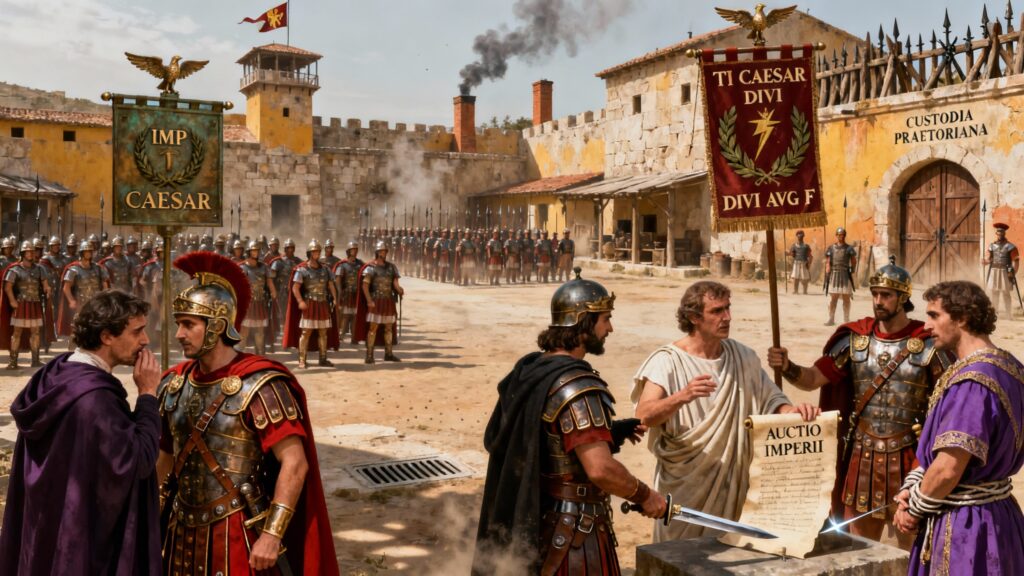
Defining the Question: Police, Army, or Kingmakers?
What “political police” means in Rome
Applying “political police” to the early Roman Empire requires care. Rome had no modern police force. Urban order in the capital involved multiple institutions:
- Cohortes urbanae kept public order in Rome.
- Vigiles acted as night watch and fire brigade.
- The Praetorians guarded the emperor, his household, and key political spaces, escorted high-value prisoners, and could execute arrests on imperial command.
When wielded by emperors and their prefects, the Guard’s coercion—surveillance, targeted arrests, intimidation of senators—functions as political policing. Their prefects also became high judicial officers, especially by the Severan period, further entangling the corps with political control of elites.
The Guard as an elite military unit
Militarily, the Praetorians were a concentrated elite cohort stationed at the heart of imperial power. They drew higher pay than legionaries, received privileged donativa, and were equipped and trained as combat troops. They campaigned with emperors and could fight outside Rome as shock infantry and cavalry. Their military capacity was real and repeatedly demonstrated during civil conflicts and palace coups alike.
Kingmakers: the decisive synthesis
In practice, the Guard’s political-police functions and military character fused into a kingmaking institution. Stationed within striking distance of the forum, senate, and palace, organized as professional soldiers, and incentivized by pay and privilege, the Praetorians were ideally positioned to arbitrate legitimacy during the frequent succession crises that characterized the Principate. They were a solution to the problem of imperial vulnerability that—by clustering force at the center—created a more dangerous problem: the weaponization of proximity.
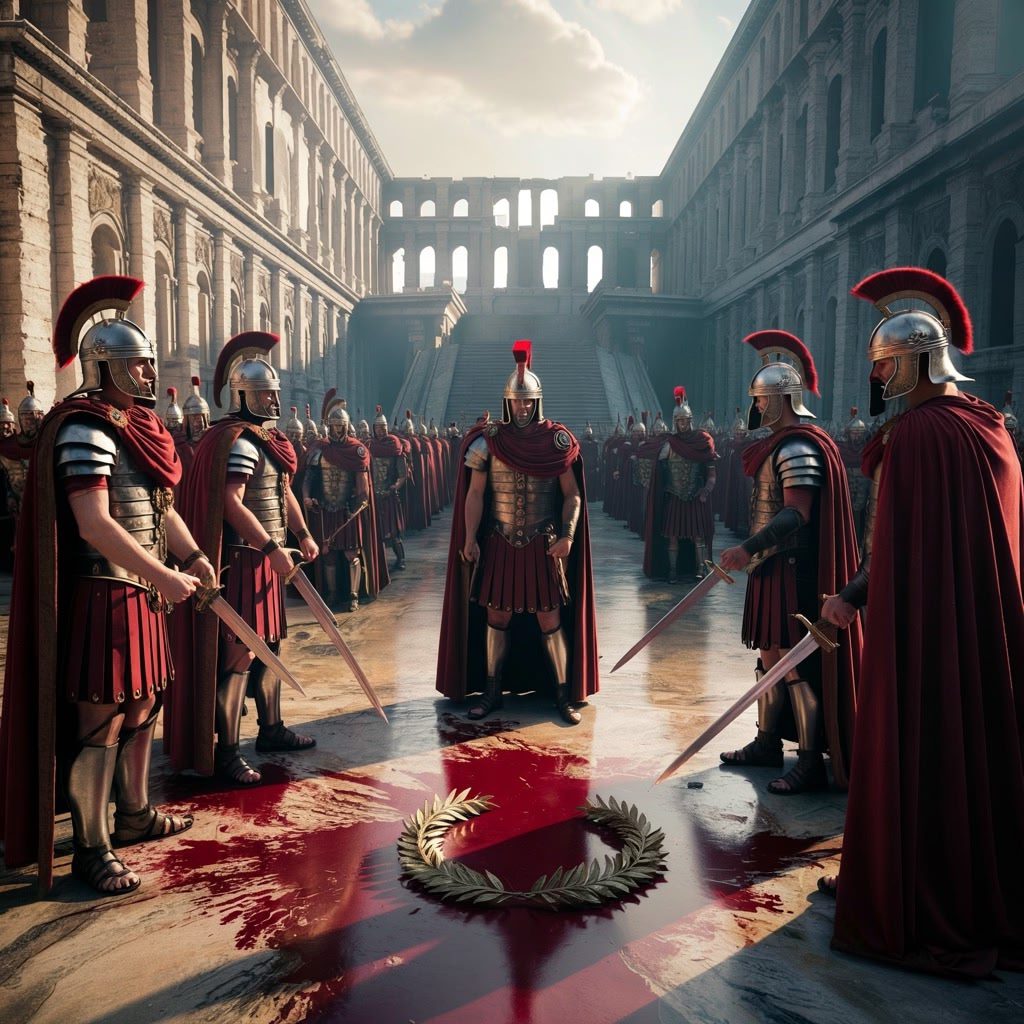
Republican Antecedents and Augustan Foundations
Republican roots of a protective corps
The concept of a commander’s bodyguard predated Augustus. During the Republic, generals maintained praetorian cohorts (cohortes praetoriae) as ad hoc protective details in the field. These were not permanent institutions in Rome, nor did they wield political authority in the city. Their lineage, however, provided the Augustan regime a precedent to normalize a permanent, professional corps attached to the princeps.
Augustus’s design and early institutionalization
Augustus—ever the constitutional illusionist—needed a guard that preserved his security while preserving the façade of republican norms. During the late first century BCE he organized select cohorts under equestrian prefects to operate in and near the capital while avoiding conspicuous militarization of the city. The formalization of these cohorts unfolded over the early Principate; by the opening years of the first century CE, the Guard existed as a recognizable imperial corps with defined privileges, fixed pay higher than the legions, and a clear command under one or more Praetorian Prefects.
If the precise moment of “creation” eludes a single date, the Augustan achievement is clear: he transformed episodic personal guards into a standing institution embedded in the new political order. This was the first move in a political chess game that would bind the emperor’s survival to the loyalty—fides—of men whose profession was force.
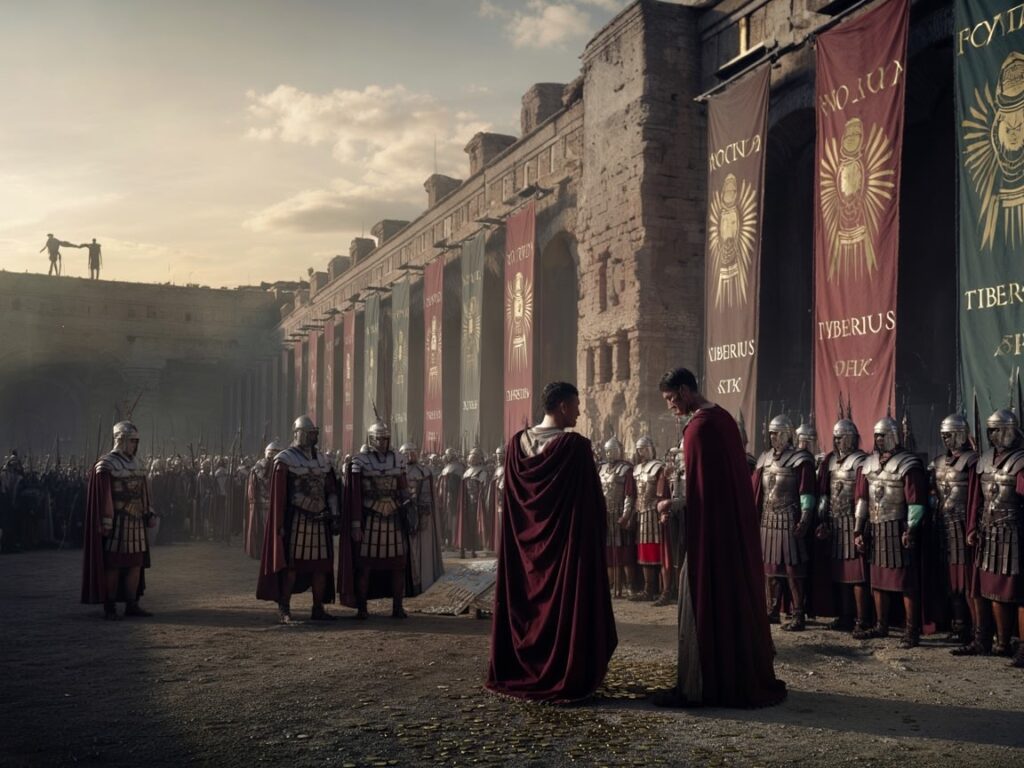
Privilege, pay, and purpose
Augustus’s Guard was shaped by incentives:
- Higher stipendium and shorter terms of service than legions ensured attraction and loyalty.
- Access to the capital’s wealth and patronage networks interlaced soldiers’ interests with imperial favor.
- Ritualized loyalty oaths (sacramentum) reaffirmed personal allegiance to the emperor, not to the abstract res publica.
The Augustan calculus was elegant: rewards would bind, and proximity would protect. Yet proximity empowers, and rewards can be renegotiated at swordpoint.
Tiberius, Sejanus, and the Castra Praetoria
Consolidation under Tiberius
Upon Augustus’s death, Tiberius inherited not only an empire but a delicate compact with the Guard. He elevated Lucius Aelius Sejanus, co-prefect with his father, to de facto control of the corps. Sejanus understood the logic of proximity better than any man of his age: a bodyguard dispersed around Rome was a liability; a bodyguard concentrated was both shield and spear.
Building the Castra Praetoria
Around 23 CE, under Sejanus’s influence, the Castra Praetoria was constructed on the northeastern edge of Rome. For the first time, the Guard was housed in a single fortified camp within reach of the city center. The implications were profound:
- Command and control: Sejanus could mobilize the Guard quickly and coherently.
- Symbol and signal: A fortress in the capital announced that military force now lived at Rome’s political heart.
- Leverage: A unified Guard could compel obedience from senate and people alike.
The Castra Praetoria turned the Guard into a political fact as well as a military instrument. It provided the spatial infrastructure for future interventions in imperial succession.
Sejanus as would-be kingmaker
Sejanus’s rise illustrates how the Prefecture could eclipse the emperor’s other advisors. He prosecuted senators, arranged alliances, and secured the public’s favor. His fall—engineered by Tiberius in 31 CE—exposed the risks of fusing political police and palace guard in a single command. Sejanus’s execution sparked purges; the Guard’s complicity and obedience to an absent emperor’s orders revealed an important counterpoint: the Prefecture could act, but the office was potent because the Guard accepted the emperor’s authority. “Princeps legibus solutus est,” but only so long as the men in the Castra Praetoria assented in deed.
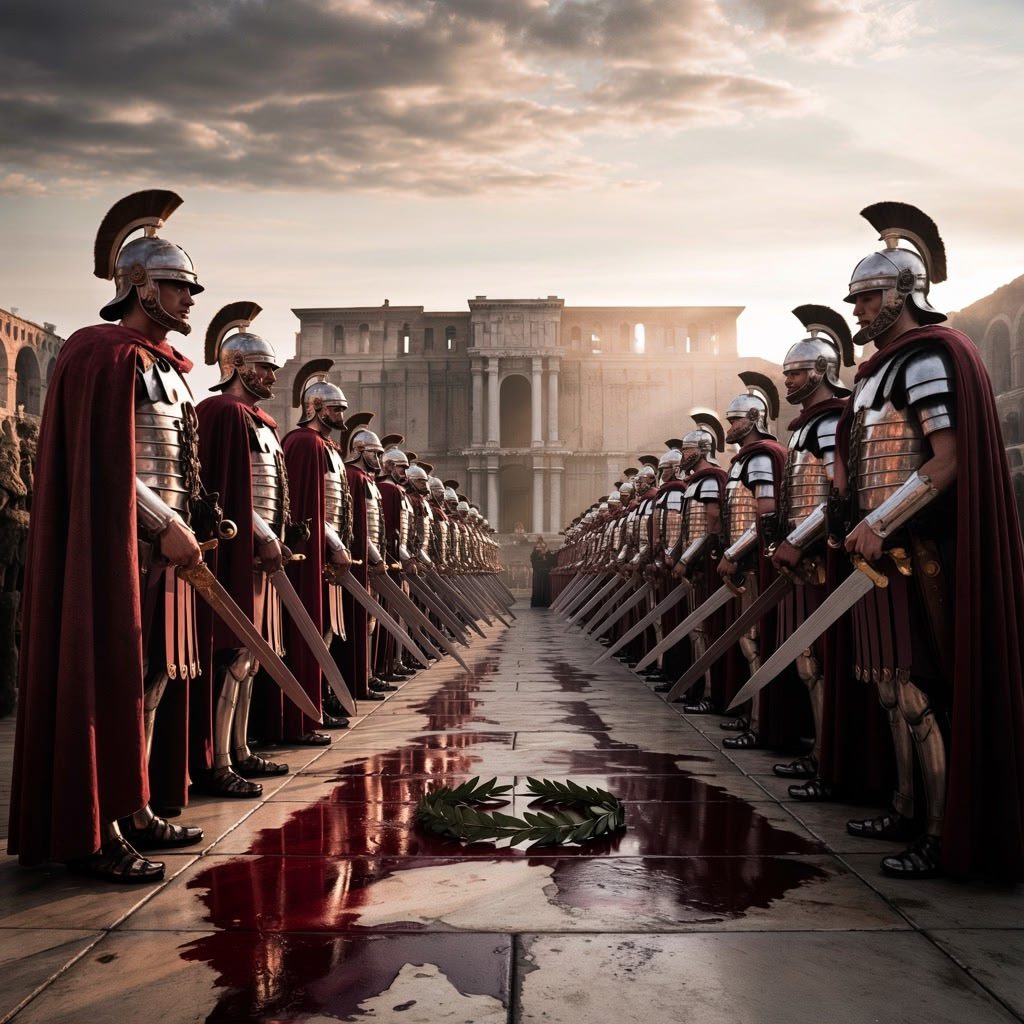
Caligula’s Assassination and the Elevation of Claudius
The first imperial blood in the palace
In 41 CE, the assassination of Caligula by officers of the Praetorian Guard (notably tribune Cassius Chaerea) marked a watershed: the Guard had not merely coerced policy; it had removed the emperor. What followed was decisive. Rather than restore republican governance, the Praetorians discovered Claudius hiding in the palace and proclaimed him emperor. The message to the senate was unmistakable: legitimacy now flowed from the swords stationed on the edge of Rome.
Donativa and the political economy of loyalty
Claudius understood the economy at work. He paid a generous donativum to the Guard upon his accession, reinforcing a pattern that would become a structural feature of the Principate: the loyalty of the Guard was to be purchased at every succession. This expectation transformed the corps into stakeholders in the imperial market. “Omnia Romae venalia”—at Rome, all things are for sale—acquired a new imperial inflection.
Year of the Four Emperors: Galba, Otho, Vitellius, Vespasian
The Guard against Galba
The chaos of 68–69 CE magnified the Guard’s centrality. Galba’s parsimony and moralism antagonized the Praetorians, who had been promised largesse for their support. When he reneged, they turned on him. His assassination by elements of the Guard in the Roman Forum underscored a brutal lesson: proclamations without paymasters were speeches to the wind.
Otho’s brief alliance
Otho secured the Guard’s support with promises and donatives, becoming emperor in January 69. His brief reign collapsed under the pressure of Vitellius’s legions marching from Germany. Even in a moment when provincial armies decided the civil war, the Guard’s endorsement remained the crucial license to sit on the throne in Rome.
Vitellius and the costs of urban force
Vitellius entered Rome buoyed by his own loyal troops, including cohorts that rivaled the Praetorians. Disorder, pillage, and factional fights in the capital highlighted the basic contradiction of standing armies in cities. This period also reveals a structural check on Praetorian supremacy: provincial legions could topple an emperor regardless of Praetorian preferences.
Vespasian resets the equation
Vespasian’s victory restored order. He reorganized the Guard, disbanded hostile cohorts, and repopulated the corps with supporters. The lesson became canon: each new regime would purge and reconstitute the Guard to secure loyalty. Institutional memory was reset by design—at the price of stability.
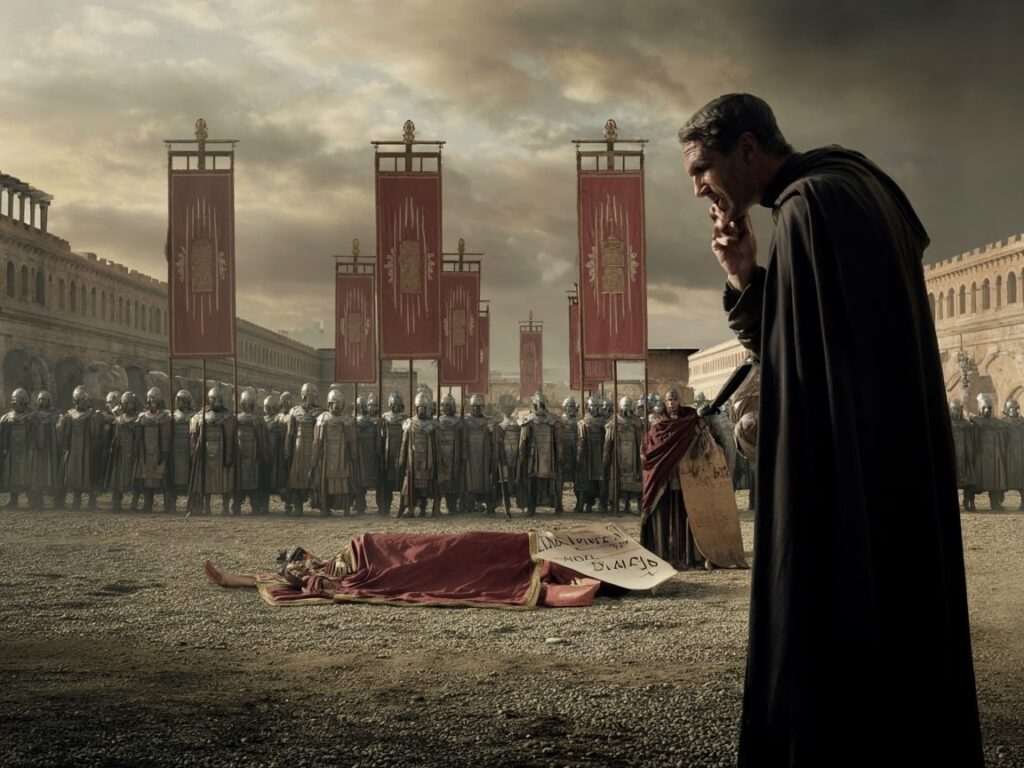
The Antonines: Calm Above, Tension Below
Institutional maturity during relative peace
The second century under the adoptive emperors is often painted as Rome’s golden age. Under Nerva, Trajan, Hadrian, Antoninus Pius, and Marcus Aurelius, the Guard settled into an elite corps with ceremonial prominence and genuine military functions accompanying the emperor on campaign. Their prefects, often experienced equestrians, increasingly exercised judicial and administrative responsibilities, especially outside the senate’s purview.
The judicialization of the Prefecture
By the Severan period the Praetorian Prefect had become one of the most powerful officials in the empire, presiding over criminal courts, handling appeals, and acting as a de facto minister of internal security. The Guard’s identity as a political police thus became more institutional and legalistic, not only coercive. The sword was sheathed within a legal framework that gave the Prefecture everyday leverage over elites.
The price of stability: donativa as routine
Even in peace the expectation of donativa persisted. Emperors budgeted not just for roads and aqueducts but for loyalty payments. The fiscalization of allegiance sowed seeds for later crises, yoking the treasury’s health to the Guard’s satisfaction.
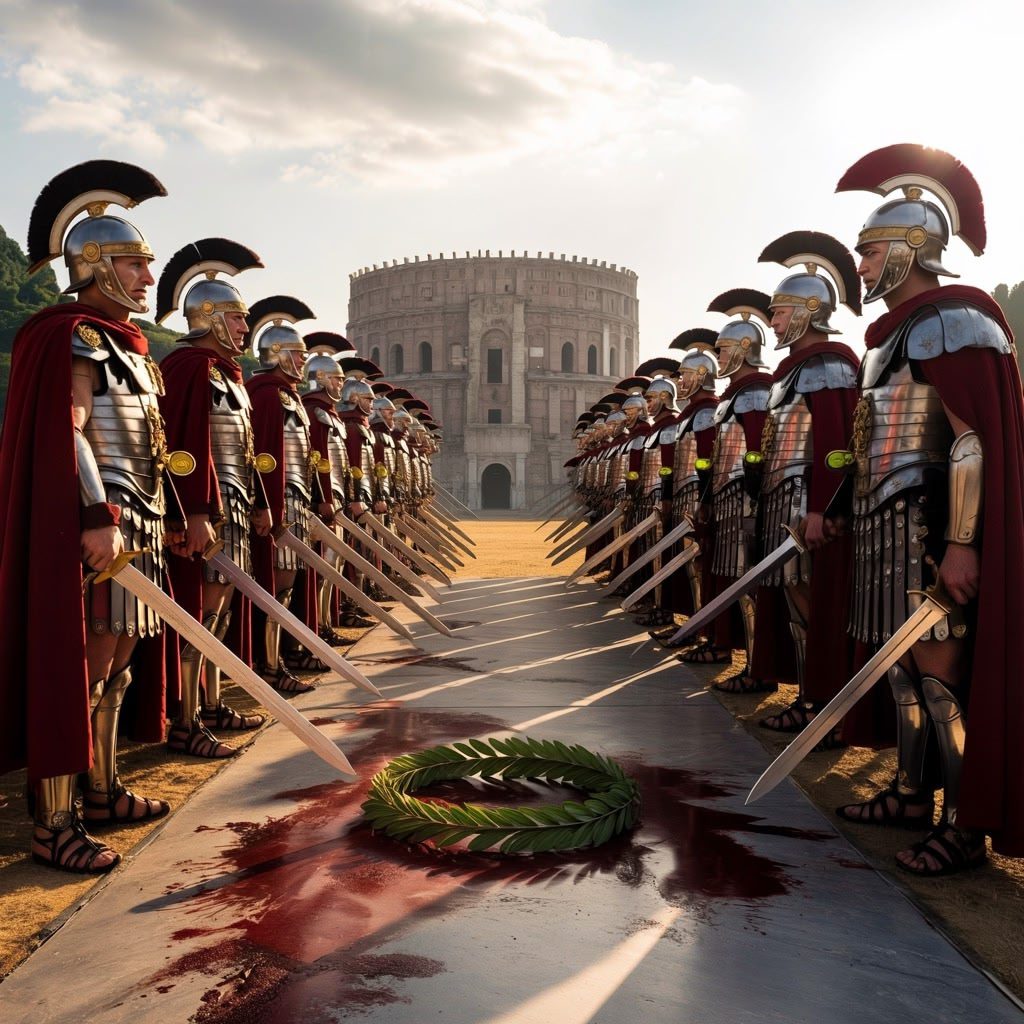
The Assassination of Commodus and the Crisis of 193
The fall of Commodus
Commodus’s assassination on the last day of 192—strangled by the athlete Narcissus at the behest of conspirators—did not feature Praetorians as executioners, but the Guard’s prefects and officers were embedded in the conspiracy’s orbit. The crucial point is less who wielded the garrote than who could legitimize what came next. Without the Guard’s acquiescence, no new emperor could hope to hold the palace.
Pertinax: virtue without base
Pertinax, a senatorial choice, attempted to restore discipline and fiscal probity. He confronted the Guard directly, seeking to rein in expectations and assert authority. The result was tragic and instructive: after only eighty-six days, Praetorians stormed the palace and murdered him. A moral emperor without a political-military base in Rome was a lamb among wolves.
The auction of the empire to Didius Julianus
What followed etched itself into Roman memory. The Praetorians effectively auctioned the imperial office to the highest bidder. Didius Julianus won by promising an enormous donativum. This event, shocking even to jaded Romans, crystallized the Guard’s transformation from protectors into proprietors of political violence. “Romae omnia venalia” had become imperial policy. Yet even this purchase could not buy legitimacy beyond the walls. Provincial armies rallied behind Septimius Severus, whose march on Rome would end the auction and remake the Guard.
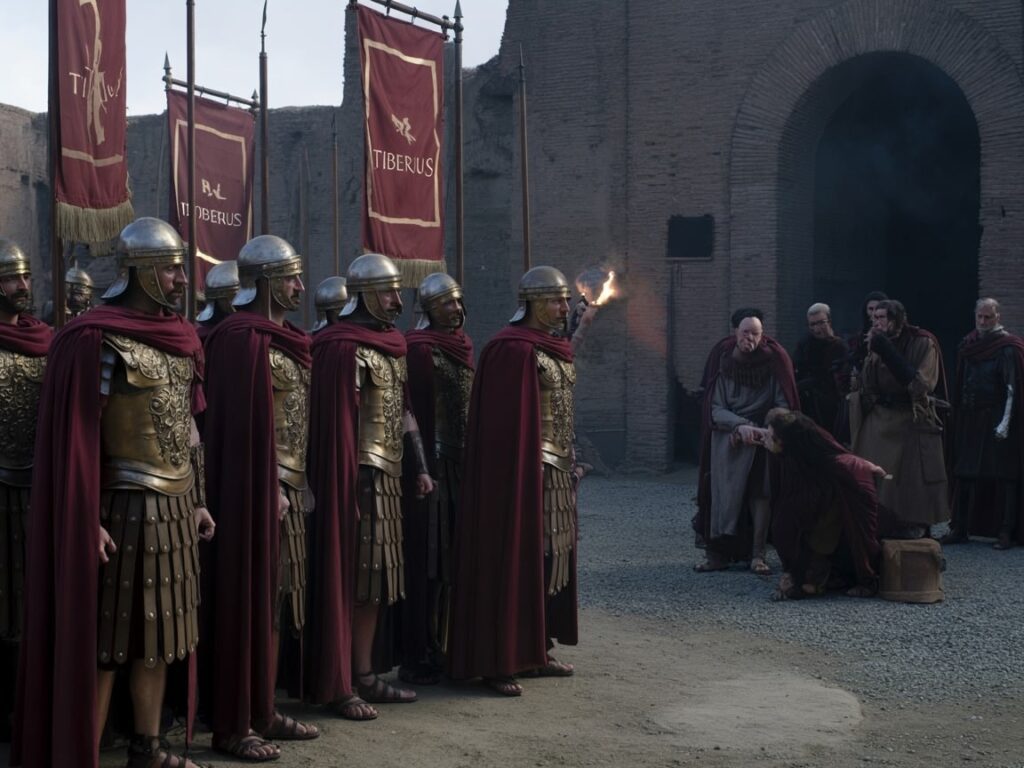
Septimius Severus and the Reforging of the Guard
Purge and refoundation
Severus executed or dismissed the Praetorians responsible for Pertinax’s death and Didius Julianus’s elevation, replacing them with troops from his own legions. This decisive purge achieved two ends:
- It severed the Guard from the faction that had humiliated the Principate.
- It militarized the corps further by infusing it with hardened veterans loyal to Severus personally.
From this point the Guard’s military character, already real, grew even more pronounced.
Donativa institutionalized, power centralized
Severus paid heavily to secure support but also centered the Guard in the new order. The Prefecture expanded in administrative scope, and the emperor’s sons (Caracalla and Geta) inherited a Praetorian apparatus that could be both shield and dagger in fraternal rivalry. The murder of Geta in the palace by Caracalla, in the presence of the Guard, exemplified again how palace violence and military presence fused in the heart of government.
Prefects as power brokers
The office of Praetorian Prefect reached a high point under the Severans. Figures like Gaius Fulvius Plautianus and later Ulpian show divergent faces of the role: the former as political strongman with immense patronage, the latter as jurist whose expertise embodied the Prefecture’s legal authority. That a jurist could lead the emperor’s guard reflects a matured duality: the Prefect as both guardian and governor.
The Third-Century Storm: Crisis and Opportunity
Multiplying emperors, multiplying interventions
The third century’s “Crisis of the Empire” multiplied pretenders, usurpers, and short reigns. The Guard’s participation in rapid-fire acclamations and assassinations accelerated. In a landscape where frontier legions manufactured emperors in the provinces, the Praetorians’ role became one of gatekeeper to Rome’s political theatre: they could ratify a usurper or bar his entry to the capital.
The economics of loyalty under strain
With inflation, debasement of coinage, and fiscal crisis, emperors struggled to meet the Guard’s financial expectations. This reality sharpened the edge of bargaining. A donativum unpaid or reduced risked mutiny; one paid might starve other parts of the state. The Guard’s presence near the treasury and palace made them the loudest creditors in an economy of force.
The diffusion of elite troops
Diocletian’s Tetrarchic reforms began to reshape imperial military geography, emphasizing mobile field armies (comitatenses) and lessening the unique strategic role of the Praetorians. Still, the Guard remained symbolically central in Rome until the decisive moment under Constantine.
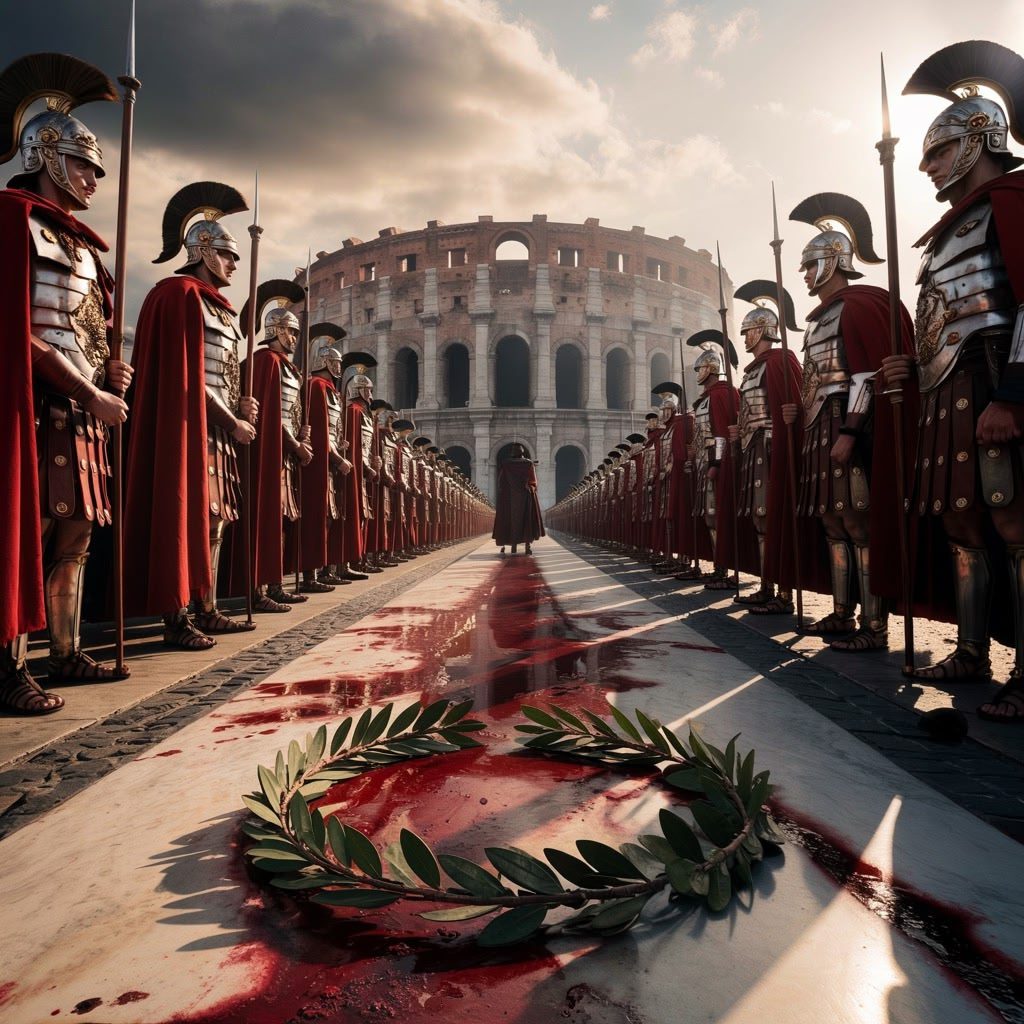
The Endgame: Constantine and the Suppression of the Guard
The Milvian Bridge and a new order
In 312, Constantine’s victory over Maxentius at the Milvian Bridge ushered in a new political-religious order and a reconfiguration of the imperial military household. Maxentius had leaned on the Praetorians; their defeat and Constantine’s consolidation provided both motive and opportunity to eliminate a perennial risk at the heart of Rome.
Disbandment and demolition
Constantine disbanded the Praetorian Guard and ordered the demolition of the Castra Praetoria. In institutional terms, this was a revolution:
- It ended the experiment of a massive standing elite corps housed in the capital.
- It replaced the Guard with new palace units (scholae palatinae) more tightly bound to the emperor’s person and less embedded in Rome’s urban politics.
- It signaled a broader shift of imperial gravity away from Rome toward new centers and new military geographies.
Thus ended three centuries of a corps that had defined the political physics of the Principate. “Imperium sine fine” endured, but without the men who once claimed to guarantee it at sword’s length.
Anatomy of Power: Organization, Recruitment, and Culture
Who were the Praetorians?
Recruitment patterns varied by period. In the early Principate, Praetorians were drawn from Italy and, increasingly, from Romanized areas with high “trust” capital. Over time, especially after Severus, the corps included more battle-hardened veterans from the legions. Distinctions from legionaries included:
- Higher pay and privileges.
- Shorter terms of service and earlier discharge bonuses.
- Close access to imperial ceremony, pageantry, and personal patronage.
These advantages created a distinct esprit de corps, visible in inscriptions and titulature emphasizing fides (loyalty), virtus (valor), and pietas (duty). Yet the ideology of loyalty was shadowed by the practice of leverage.
The Prefecture: the empire’s sharpest civilian sword
The Praetorian Prefect began as a military commander of the Guard but evolved into a complex magistracy situated at the intersection of military command, judicial authority, and imperial administration. By the second and third centuries:
- Prefects adjudicated major criminal cases and appeals.
- They managed aspects of imperial logistics and finance.
- They served as counselors with influence over succession and policy.
This concentration of functions made the Prefecture the empire’s most potent equestrian office. If the emperor was the sun, the Prefect was a gravitational planet that shaped orbits.
Rituals of loyalty and the politics of proximity
The Guard’s culture relied on ritual: oaths, donatives, parades, and funerary honors. Ritualized loyalty normalized the expectation of reciprocal generosity. The Guard protected not an abstract constitution—“res publica”—but a living person who was both man and office. Personalism sharpened both loyalty and betrayal.
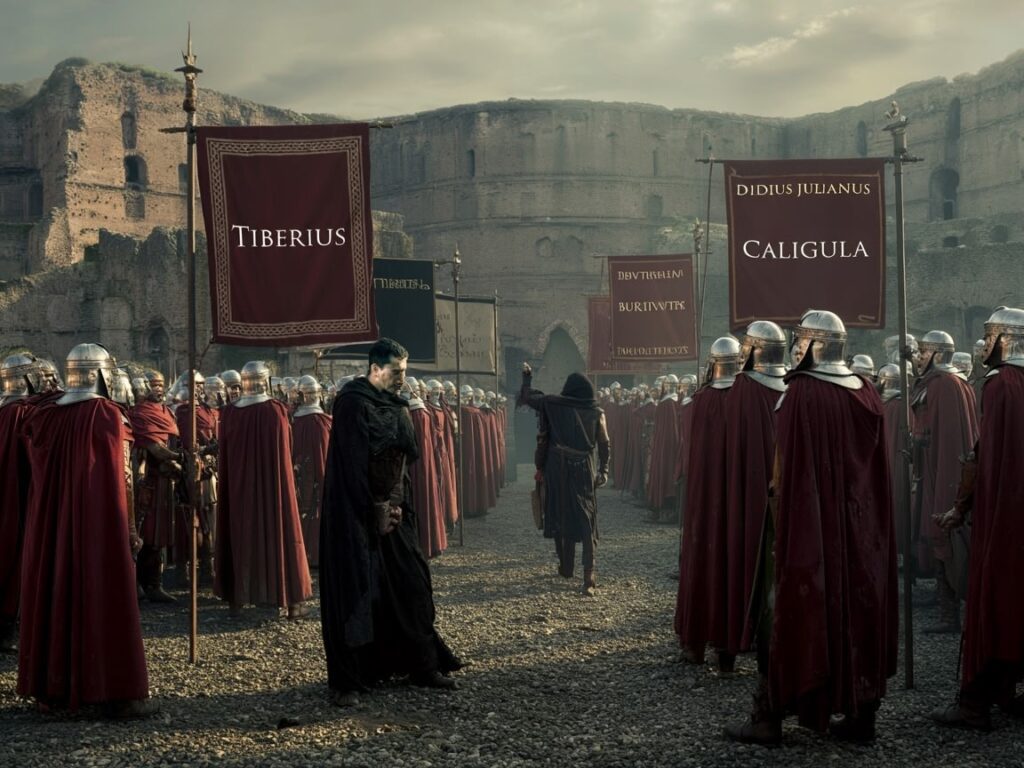
Political Police in Practice: Methods and Boundaries
Surveillance, arrests, and intimidation
In the hands of a ruthless emperor or an ambitious Prefect, the Guard enacted surveillance and arrests of senators and equestrians under charges of treason (maiestas). Beyond legal warrants lay the informal politics of fear: a Praetorian detachment at a noble’s door was an argument difficult to refute. This function—policing elite politics—distinguishes the Guard from line soldiers.
Managing the symbolic city
The Guard also managed political theater. Appearances of imperial majesty, control of access to the palace, and presence at ceremonies were part of a constant dramaturgy of power. Their visible backing turned imperial edicts into embodied authority. Conversely, their absence or hostility drained a reign of charisma. In Rome, optics were a strategy.
Boundaries and frictions with other corps
The cohortes urbanae and the vigiles often bore the burdens of everyday urban order. Frictions emerged when jurisdictions overlapped or when the Praetorians intervened to impose imperial will. Overreach could delegitimize emperors; underreach could embolden rivals. The best emperors kept their Guard as a visibly sheathed sword: present, ready, but not wantonly used.
Kingmakers at Work: Case Studies
Caligula and Claudius (41 CE)
- Trigger: Personal grievances and fear of despotism among officers like Chaerea.
- Action: Assassination within palace precincts; immediate power vacuum.
- Outcome: Claudius discovered and acclaimed by the Guard; senate sidelined.
- Lesson: The Guard could kill and consecrate in a single day.
Pertinax and Didius Julianus (193 CE)
- Trigger: Pertinax’s austerity and attempted discipline alienated the Guard.
- Action: Praetorians murdered the emperor; auctioned support to the highest bidder.
- Outcome: Didius Julianus purchased the throne but lacked broader legitimacy; Severus ended the experiment by force.
- Lesson: Without alignment between Guard and provincial legions, a bought crown is a paper diadem.
Commodus (192 CE) and the politics of palace murder
- Trigger: Increasing instability, court intrigues, and alienation of elites.
- Action: Assassination by a conspirator outside the Guard; yet the corps’ acceptance remained decisive.
- Outcome: Transition to Pertinax failed because the Guard would not be reformed by exhortation alone.
- Lesson: Even when not executioners, Praetorians framed the succession.
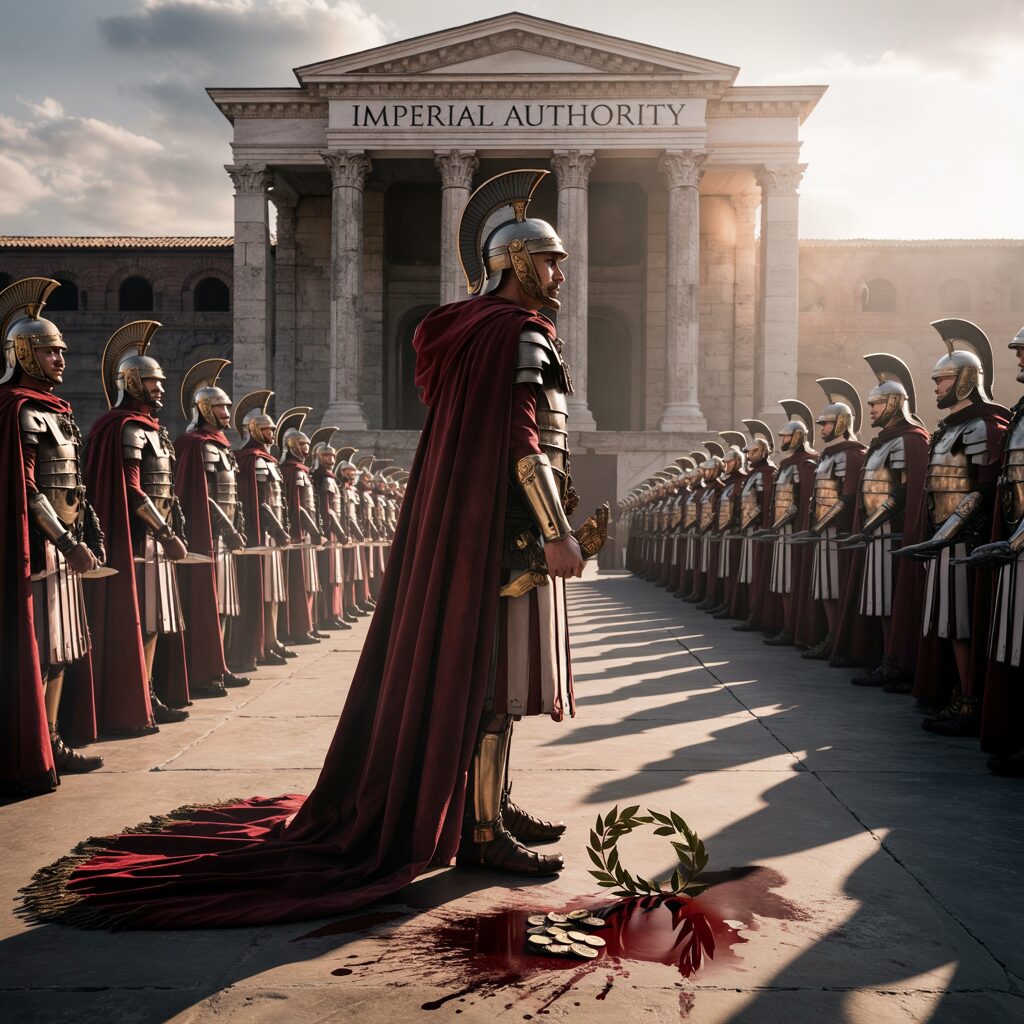
Language, Power, and Law: The Ideology of the Guard
Latin maxims that haunted the palace
Certain Latin formulations capture the Guard’s political grammar:
- Quis custodiet ipsos custodes? The insoluble problem of oversight over those who hold coercive power.
- Imperatorem facit exercitus. The army’s role in creating emperors.
- Princeps legibus solutus est. The legal supremacy of the emperor—effective only with military assent.
- Omnia Romae venalia. A comment on corruption that took institutional form in donativa.
These phrases are not mere ornaments; they describe a system where legitimacy and force circulate through the same channels.
The oath and the gift
The sacramentum bound soldiers to the emperor; the donativum bound the emperor to the soldiers. This mutual contract, sanctified by ritual and sealed by pay, is the economic substrate of kingmaking. Breaking either side invited catastrophe.
Image and emblem
Praetorians cultivated an image as both guardians and exemplars. Their standards, decorations, and appearances in public ceremonies transmitted a message: they were the emperor’s visible hand. When that hand turned inward, it communicated a different message: the skin of the state was thin.
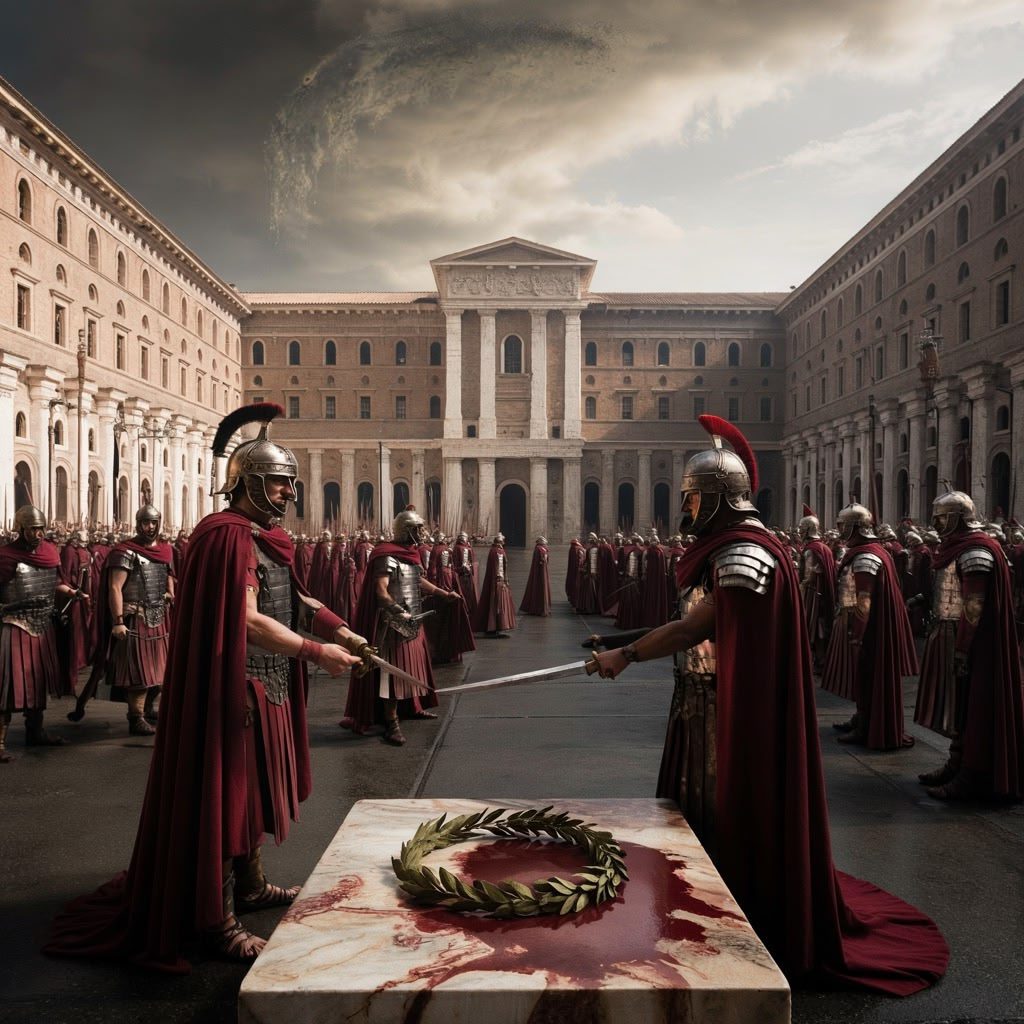
Comparisons: Palace Guards Across Empires
A wider pattern
Rome’s Praetorians share family resemblance with other elite corps:
- The Varangian Guard in Byzantium: foreign muscle to reduce local factionalism; less integrated in urban politics, more tied to the emperor personally.
- The Mamluks and Janissaries: elite slave-soldier systems that evolved into independent political forces, at times deposing sultans.
- The Streltsy in Muscovy: household troops whose uprisings reshaped succession.
The pattern is recurrent: concentration of elite, well-paid armed men near the sovereign creates both shield and potential usurpation. Institutional design can mitigate but not eliminate the structural temptation to arbitrate succession.
What made Rome’s case distinctive
Rome’s Praetorians operated in a city where the senate, people, and rituals of republican memory still mattered. Their interventions therefore had to produce not only force but narrative: a justification, however thin, that the new emperor was rightful. Claudius’s acclamation by the Guard worked because it could be narrated as providence; Didius Julianus’s purchase failed because it could not be narrated as anything but commerce.
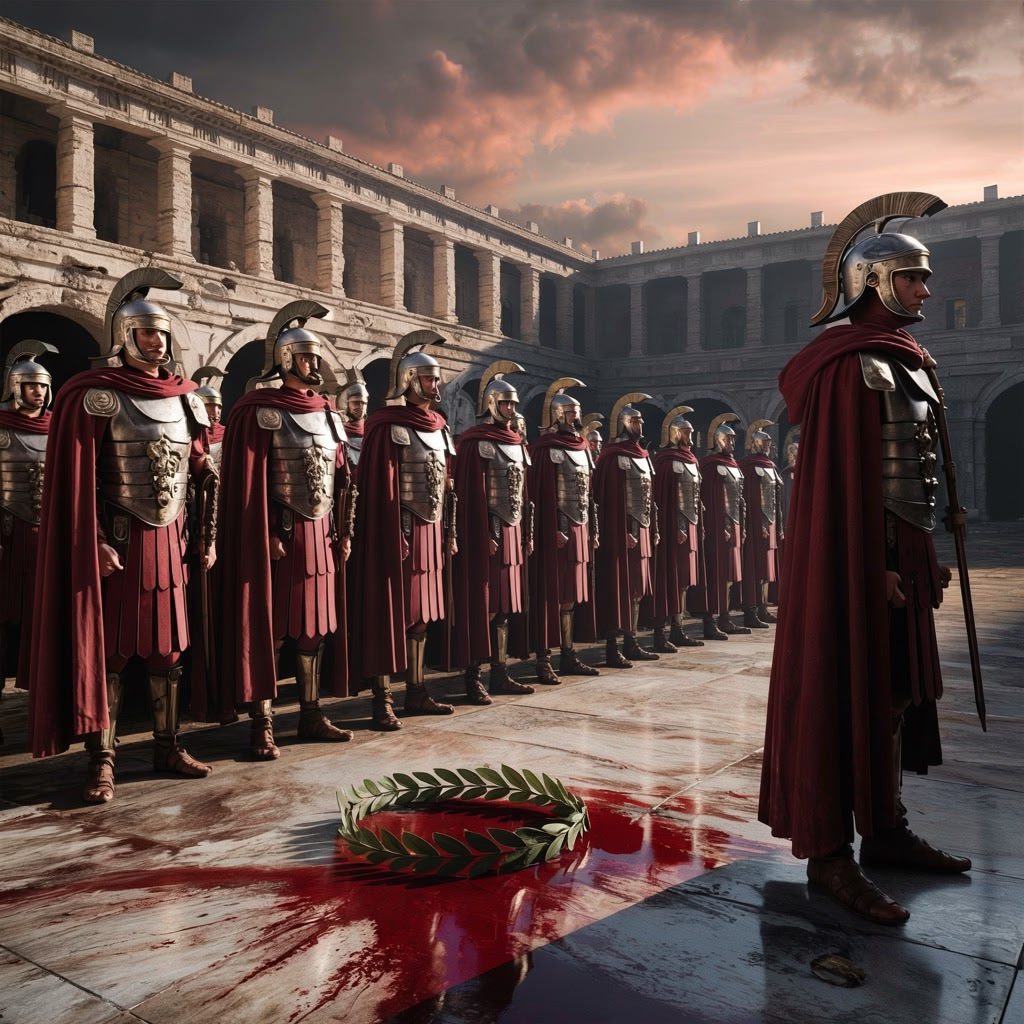
Were They Political Police or Military Force?
The case for political police
- Proximity to the emperor’s person and palace grounded their role in regime security.
- Participation in arrests, intimidation, and execution of political enemies placed them in the realm of coercive political control.
- The Prefecture’s judicial expansion imbued the corps with legal instruments of repression.
The case for military force
- Organization into cohorts with battlefield training and equipment made them real soldiers, not mere courtiers.
- Campaign service—escorting emperors, fighting in civil wars, and acting as shock troops—proved operational capability.
- Their decisive actions often took classic military forms: sieges of the palace, occupation of the forum, barricading strategic sites.
The synthesis: military-police sovereignty
The Praetorian Guard must be understood as a military-police hybrid whose authority derived from occupying the space where sovereignty is performed. Their political-police tactics were credible because backed by arms; their military force was politically constitutive because exercised at the seat of the state. In modern terms, they were an executive protection agency, a federal police, and an elite guard unit rolled into one, without the checks that separate such functions today.
Why They Made and Unmade Emperors
Proximity, pay, and perception
- Proximity: They stood closest to the emperor’s body and the levers of power.
- Pay: Donativa and privilege aligned their interests with the succession moment, inviting intervention.
- Perception: The Guard was the visible symbol of imperial control; their posture communicated legitimacy to the city.
Institutional incentives to intervene
At each succession, a rational Praetorian cohort faced a choice: accept the designated heir and receive standard largesse, or leverage the moment to extract more from a candidate who needed their immediate endorsement. Over time this logic normalized bargaining backed by force.
The weakness of alternative legitimations
Senatorial acclamation or provincial support mattered, but neither could be enacted in the palace as quickly as the Guard’s endorsement. The senate could proclaim, the provinces could threaten, but the Guard could open or shut the palace gates.
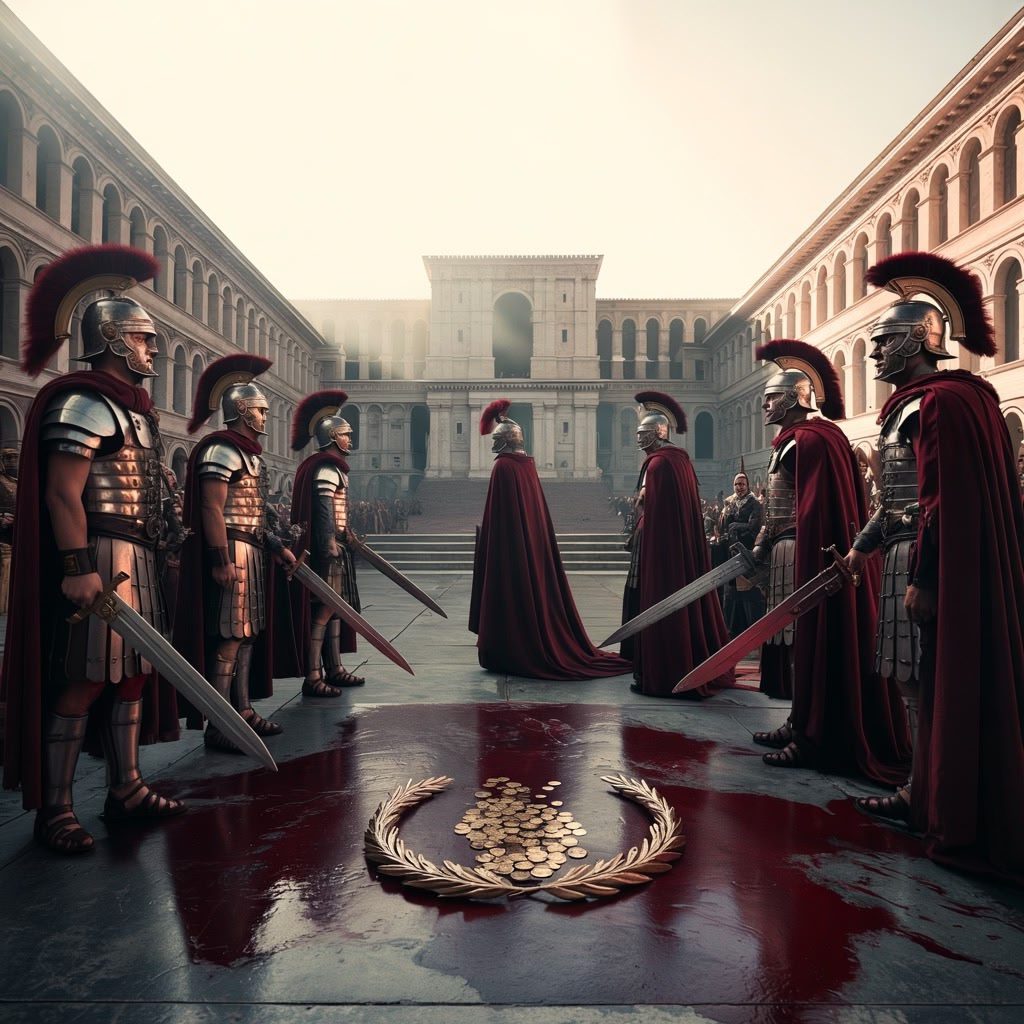
Limits of Praetorian Power
The provinces strike back
The Year of the Four Emperors and Severus’s march on Rome demonstrate limits: provincial legions could and did overthrow Praetorian decisions. The Guard’s power was maximal within the urban and ceremonial core; beyond it, the field armies wrote the final verdicts.
The emperor’s countermeasures
Shrewd emperors mitigated Praetorian risk:
- Rotation of cohorts and mixed recruitment to avoid unified factionalism.
- Splitting commands between co-prefects to prevent a second Sejanus.
- Counterweights like the cohortes urbanae, German bodyguards in earlier periods, or later palace units.
Yet each measure had costs and could not permanently negate the structural logic of proximity.
The constitutional lie revealed
The Principate lived on the constitutional fiction that the princeps was merely first among equals. The Guard made the fiction visible by deciding when the equals ceased to matter. The spectacle of their interventions was the rupture where the “republican” mask slipped.
Constantine’s Solution and Its Legacy
Abolition as institutional design
By disbanding the Praetorians and razing their camp, Constantine did more than punish a defeated faction; he redesigned the imperial center to reduce the risk of kingmaking by a single urban corps. The scholae palatinae, smaller and more directly tied to the emperor’s person, diluted corporate power and relocated sovereignty’s spectacle away from a single Roman barracks.
The long echo
The problem, however, did not vanish. Later imperial systems continued to wrestle with palace guards turned political actors. Constantine’s solution reminds us that no regime can remain indifferent to the geometry of force around the sovereign. The layout of barracks is a constitutional clause.
Conclusion: The Guard’s Answer to the Question
The Praetorian Guard was both political police and elite military, but this binary obscures their true historical role: they were the medium through which Rome translated force into legitimacy at the imperial center. Created by Augustus to stabilize a fragile settlement, consolidated under Tiberius with the Castra Praetoria, they became the decisive arbiters of succession—killing Caligula, selling the empire to Didius Julianus after murdering Pertinax, and negotiating the violent threshold of power in the late Republic’s shadow. Constantine’s abolition in 312 acknowledged a hard-won truth: a political order that concentrates elite troops at the sovereign’s doorstep writes its succession in the grammar of steel.
The fascination of the Praetorians lies not only in the drama of assassinations and auctions but in the clarity with which they expose a perennial problem of governance. Even the most celebrated princeps could be, in the last resort, a man among armed men. Rome’s solution—“guard the guardian”—reached its end when the empire accepted that the guardianship could not be trusted to a single camp. Quis custodiet ipsos custodes? In Constantine’s Rome, the answer was: no one—and therefore, no more Praetorians.

